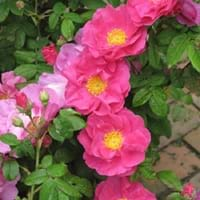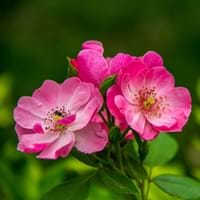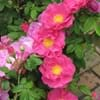Life Span
Perennial
Perennial
Type
Perennial
Flowering Plants
Origin
Central Europe, Southern Europe
Europe, India, Northwestern Africa, United States, Western Asia
Types
Not Available
Not Available
Habitat
Temperate Regions
disturbed sites, Roadsides, stream banks, Woods
USDA Hardiness Zone
5-9
Not Available
AHS Heat Zone
9-1
Not Available
Sunset Zone
H1, H2, 6, 7, 8, 9, 12, 13, 14, 15, 16, 17, 18, 19, 20, 21, 22, 23, 24
Not Available
Habit
Upright/Erect
Upright/Erect
Flower Color
Dark Purple, Pink, Purple
Lavender, Light Pink, Pink, Purple, White
Flower Color Modifier
Not Available
Bicolor
Fruit Color
Dark Blue, orange brown
Non Fruiting Plant
Leaf Color in Spring
Dark Green
Green, Gray Green, Dark Green
Leaf Color in Summer
Dark Green
Green
Leaf Color in Fall
Dark Green, Yellow green, Orange Red
Green, Gray Green, Dark Green
Leaf Color in Winter
Light Green
Green, Dark Green
Leaf Shape
Pinnate
Pinnate
Plant Season
Spring, Summer, Fall
Spring, Summer
Sunlight
Full Sun, Partial Sun
Partial shade, Partial Sun
Growth Rate
Medium
Medium
Type of Soil
Loam, Sand
Clay, Loam
The pH of Soil
Acidic, Neutral
Alkaline
Soil Drainage
Well drained
Well drained
Bloom Time
Spring, Late Spring, Early Summer, Summer, Late Summer, Early Fall, Fall
Spring, Summer
Repeat Bloomer
Not Available
Yes
Tolerances
Drought
Wet Site
Where to Plant?
Container, Ground, Pot
Container, Ground, Pot
How to Plant?
Cuttings
Seedlings, Stem Planting
Plant Maintenance
Medium
Medium
Watering Requirements
Average Water Needs
Keep the ground moist but not water-logged
In Summer
Lots of watering
Lots of watering
In Spring
Moderate
Moderate
In Winter
Average Water
Average Water
Soil pH
Acidic, Neutral
Alkaline
Soil Type
Loam, Sand
Clay, Loam
Soil Drainage Capacity
Well drained
Well drained
Sun Exposure
Full Sun, Partial Sun
Partial shade, Partial Sun
Pruning
Remove damaged leaves, Remove dead branches, Remove dead leaves
cut main flower spike, Remove dead branches, Remove dead or diseased plant parts
Fertilizers
All-Purpose Liquid Fertilizer
Apply 10-10-10 amount, as it is a flowering plant, use high phosphorous content fertilizer
Pests and Diseases
Beetles, Black Spot, Caterpillars, Downy mildew, Mosaic viruses, Powdery mildew, Rust, Scale insects, Thripes
Grasshoppers
Plant Tolerance
Drought
Drought, Wet Site
Flower Petal Number
Double
Single
Edible Fruit
Not Available
No
Foliage Texture
Medium
Medium
Foliage Sheen
Glossy
Matte
Invasive
Not Available
No
Self-Sowing
Not Available
No
Attracts
Birds, Butterflies
Birds, Small mammals
Allergy
Rash
Constipation, Diarrhea, Headache, Heartburn, Nausea, Pain and fatigue, Stomach pain, Vomiting
Aesthetic Uses
Showy Purposes
Bonsai, Bouquets, Cottage Garden, Showy Purposes
Beauty Benefits
Not Available
Good for skin, Skin Problems
Environmental Uses
Air purification
Air purification, Food for birds
Medicinal Uses
Not Available
Astringent, Diuretic, Laxative, Vitamin C
Part of Plant Used
Flowers
Flowers, Rose Hip
Other Uses
Oil is used in perfume, soaps, creams, etc.
Making Perfumes, Used as Ornamental plant, Used for its medicinal properties
Used As Indoor Plant
Yes
Yes
Used As Outdoor Plant
Yes
Yes
Garden Design
Container, Cutflower, Feature Plant, Foundation, Mixed Border, Topiary / Bonsai / Espalier
Feature Plant, Mixed Border
Botanical Name
Rosa Gallica
Rosa Arkansana
Common Name
Rose of Provins, Gallic Rose, French Rose
Prairie Rose, Wild Prairie Rose
In Hindi
Gallica Rose
Rosa arkansana
In German
Gallica Rose
Rosa arkansana
In French
Gallica Rose
Rosa arkansana
In Spanish
Gallica Rose
Rosa arkansana
In Greek
Gallica Rose
Rosa arkansana
In Portuguese
Gallica Rose
Rosa arkansana
In Polish
Gallica Rose
Rosa arkansana
In Latin
Gallica Rose
Rosa arkansana
Phylum
Magnoliophyta
Magnoliophyta
Class
Magnoliopsida
Magnoliopsida
Clade
Not Available
Angiosperms, Eudicots, Rosids
Tribe
Not Available
Not Available
Subfamily
Not Available
Not Available
Number of Species
Not Available
Not Available
Season and Care of Gallic Rose and Prairie Wild Rose
Season and care of Gallic Rose and Prairie Wild Rose is important to know. While considering everything about Gallic Rose and Prairie Wild Rose Care, growing season is an essential factor. Gallic Rose season is Spring, Summer and Fall and Prairie Wild Rose season is Spring, Summer and Fall. The type of soil for Gallic Rose is Loam, Sand and for Prairie Wild Rose is Clay, Loam while the PH of soil for Gallic Rose is Acidic, Neutral and for Prairie Wild Rose is Alkaline.
Gallic Rose and Prairie Wild Rose Physical Information
Gallic Rose and Prairie Wild Rose physical information is very important for comparison. Gallic Rose height is 50.00 cm and width 80.00 cm whereas Prairie Wild Rose height is 300.00 cm and width 200.00 cm. The color specification of Gallic Rose and Prairie Wild Rose are as follows:
Gallic Rose flower color: Dark Purple, Pink and Purple
Gallic Rose leaf color: Dark Green
Prairie Wild Rose flower color: Lavender, Light Pink, Pink, Purple and White
- Prairie Wild Rose leaf color: Green, Gray Green and Dark Green
Care of Gallic Rose and Prairie Wild Rose
Care of Gallic Rose and Prairie Wild Rose include pruning, fertilizers, watering etc. Gallic Rose pruning is done Remove damaged leaves, Remove dead branches and Remove dead leaves and Prairie Wild Rose pruning is done cut main flower spike, Remove dead branches and Remove dead or diseased plant parts. In summer Gallic Rose needs Lots of watering and in winter, it needs Average Water. Whereas, in summer Prairie Wild Rose needs Lots of watering and in winter, it needs Average Water.





